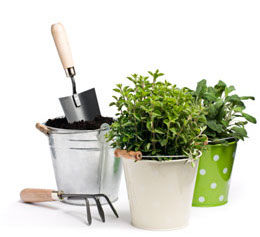Container gardening refers to the practice of growing herbs and plants in containers, instead of in the ground. The practice is very popular across the globe, aiding the efforts made towards recycling plastic containers and chipped chinaware. It is pursued by many a green thumb for ornamental purposes as well.

Container gardening is best suited for regions where the soil is unsuitable for planting or cropping herbs and plants. The concept appeals immensely to the gardener in urban areas, where space available for plantation is limited. There are a number of herbs and flowering plants that thrive in container gardens, either developed in the balcony or porch, or within the kitchen window-box. This method allows the modern homeowner to use every empty container and to infuse the home with a new spark of green! A number of fruits and vegetables can be potted in used jars and chipped china, depending on the size of the container.
The practice has many advantages associated with it. Not only are the plants exposed to lesser risk of contracting soil-borne diseases, but the gardener is able to virtually eliminate the menace of weeds. It also allows the gardener to capitalize on mobility of the potted plants and to ensure optimum control over-exposure to moisture, temperature, and sunlight. The concept, however, is not a new one. It has been around for ages, with herbs and vegetables sprouting from kitchen boxes flaunting chipped tea cups and pots, plastic jam, butter and cheese containers, and even tin pots. Today, there are a number of innovative designs generated around the concept to accommodate automatic-irrigation systems.
Vegetables and Herbs Conducive to Container Gardening
The urban green thumb is now able to make the most of the space available and the flexibility in design that the containers offer. The garden involves the potting of plants according to the root system. This helps the gardener to experiment with the development of bonsai and special pot-bound and root-bound plant varieties. Not having garden space is no longer a constraint to grow vegetables like:
- Tomatoes
- Peppers
- Green onions
- Eggplant
- Beans
- Lettuce
- Radishes
- Parsley
- Cucumber
The technique is also very helpful in growing herb-garden annuals, biennials, or perennials like:
- Anise
- Basil
- Caraway
- Chives
- Fennel
- Lovage
- Thyme
It is essential to consider the implications of drainage, porosity, and weight when choosing the material. The width of the container mouth decides the plant variety that could be opted for, since a wider mouth would facilitate quicker evaporation, while a narrower one would retain water for a longer time. There are a number of dedicated resources, online as well as offline, that allow the green thumb to access containers made of glazed ceramic, resin, fiberglass, and metal. They also enable access to synthetic soil mixes composed of sawdust, peat moss, perlite, and vermiculite.
The design and space available for the container garden largely depends on the kind of containers being used. While smaller containers are ideal for table tops, mantles, and window ledges, larger varieties adorn the yard. Container gardening offers the plants protection from pests and control-invasive plants. The containers are not only convenient to move around, but can also be displayed indoors. The effort could be theme-oriented or material-based . The home owner could choose a color, monochromatic or complimentary, or a size theme to merge with the existent indoor home décor. The choice of a material-based theme, plastic or ceramic, to infuse the porch with a touch of black-eyed susans or petunias is also popular today.






 Container gardening is best suited for regions where the soil is unsuitable for planting or cropping herbs and plants. The concept appeals immensely to the gardener in urban areas, where space available for plantation is limited. There are a number of herbs and flowering plants that thrive in container gardens, either developed in the balcony or porch, or within the kitchen window-box. This method allows the modern homeowner to use every empty container and to infuse the home with a new spark of green! A number of fruits and vegetables can be potted in used jars and chipped china, depending on the size of the container.
Container gardening is best suited for regions where the soil is unsuitable for planting or cropping herbs and plants. The concept appeals immensely to the gardener in urban areas, where space available for plantation is limited. There are a number of herbs and flowering plants that thrive in container gardens, either developed in the balcony or porch, or within the kitchen window-box. This method allows the modern homeowner to use every empty container and to infuse the home with a new spark of green! A number of fruits and vegetables can be potted in used jars and chipped china, depending on the size of the container.